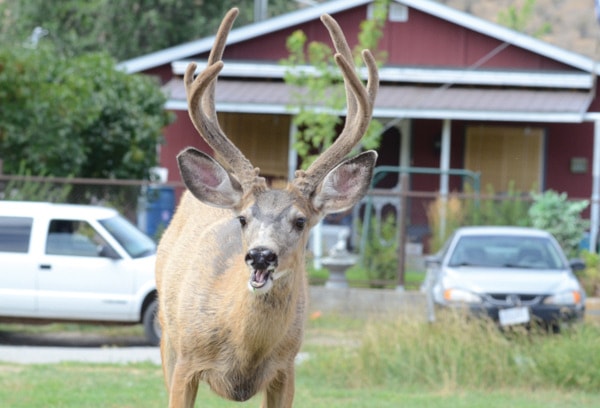The B.C. SPCA has put Penticton council’s proposed deer cull in its sights in a position paper that calls for a targeted approach to addressing local ungulate over-population.
Simon St-Laurent, volunteer chair for the SPCA’s South Okanagan Similkameen community council, said the organization is hoping to work with the city, business and residents to humanely decrease the deer population.
“Provincewide, many communities are obviously faced with the same issues. It would be nice in Penticton to maybe do something different,” St-Laurent said. “We have had some successes in other communities across the province, although not as much as I would like.
“In Penticton it’s a little bit different this year because of the weather. I just wanted to make sure that council and the public was aware of our position statement and alternatives.”
Council began grappling with the issue this summer over a notice of motion calling on the city to take immediate action to reduce the population of deer in the city to avoid conflicts. They agreed in early August to strike an urban deer management committee, that would generate recommendations for council on its options.
The SPCA stressed in its position paper released last week that it would prefer council use as many non-lethal means as possible to address urban deer issues, which would result in long-term prevention versus short-term solutions.
Relocation isn’t among those options, as studies have shown moving mature deer can result in high mortality from injuries during the move and low survival rates when released in unfamiliar territories. Contraception is also not available.
St-Laurent said he recognized that the only way to reduce a deer population is to “unfortunately” destroy the animal, but he urged policy makers to consider targeted culls rather than declaring open season.
He pointed to successes in Port Alberni, where wildlife officials culled not the whole herd, but does in heat. Those that were pregnant were spared, and the cull was conducted at only specific times of the year by wildlife officials or volunteer hunters who were trained on what to look for.
“There is a registration process, a quota for the day. It’s possible to do, but it’s very targeted. They’re not shooting at just anything,” he said. “That’s the success we’ve had, by doing it sensibly.”
The SPCA is also hoping the community can implement a plan with multiple strategies, including reducing available food that entices deer in town. While many people talk about fences around farms, St-Laurent said it would be good to involve the agriculture sector in discussions on other cost-effective ways to keep deer out of gardens.
He pointed to Oliver’s farm community as having managed “the deer population by using other, more natural and safe methods. Penticton farmers don’t know; there’s been no communication on that.”
Business and development practices might be another area to review, he said. Landscapers who are not local may suggest plants not knowing they are a food source for deer.
“How can we make it not so attractive to deer, but keep it nice and presentable? There’s a way of doing that, using different plants that can be used,” St-Laurent said. “That’s why there needs to be a few players around the table discussing those plants and processes available in reducing the attraction for the deer.”
Those involved in road and highway maintenance might also want to consider humane deterrents like reflectors that cast a light disturbance into the bush or removing salt from highways as soon as spring appears, he said. Given it was a road safety issue, St-Laurent suggested ICBC might want to be a player in discussions.
“It will take time. It has taken many, many years for the deer population to get where it is now. It will take time to undo that, and re-educate them to stay in the forest and the bush,” he said.
The result could very well be longer lasting, as addressing the food source is key to dealing with deer.
“Removing the nuisance would certainly be a success story, but it does take time. It does take the buy-in from many of the different organizations that are involved with animal welfare,” he said.
“They’re animals, too, but they go where the food is. If we provide them with food, then they’ll be where we are.”
Penticton Coun. Mike Pearce, who kick-started the debate on the issue in July with his notice of motion, said he has yet to see the report from staff on the issue, but noted many residents have contacted him out of frustration over inaction and delays.
Funding would also be an issue, he said.
“Quite frankly, I’m not looking for anything that’s going to cost the community more money for taxes. We’re not at a time when we are going to start new programs,” he said, adding the staff report may include alternative measures akin to those found in the SPCA position paper.
“I’m sure not all on council will think alike on this. We’ll see what could get through when we see the staff report on what our alternatives are. They’ve probably researched it,” he said. “We’re not out here to machine gun a whole bunch of deer. We’re here to make sure nobody dies.”
The staff report is expected to be presented to council for consideration on Tuesday.
